
Aerodynamic science was still something of a black art in the mid 1960s, which is why it was still a major focus of a particular highly regarded trophy at the 24 Hours of Le Mans. The Index of Efficiency was the second most important trophy at Le Mans, following the overall win, of course. And because it was so important, there were many teams who had no chance of winning that would go for the IoE victory.
Tiny streamliners with diminutive engines dotted the course, and as the speeds increased for the highest classed teams, it became quite dangerous for all parties involved, which is why the idea was abandoned. This car, the Panhard CD LM64 is likely to blame for the death of this class. Despite neither of the two entered actually finishing the race, or winning the trophy, they won my heart.
The Mk1 Ford GT40 was introduced to Le Mans in 1964. That’s something you immediately think of as having a low slung and slippery shape, right? That car with its “Le Mans nose” is quoted as having a coefficient of drag in the 0.35 range. What did this little Panhard streamliner achieve? Its coefficient of drag is a Le Mans record of 0.12. That’s absurdly low!
So we’ve established that the CD LM64 is extremely aerodynamically efficient. It was also extremely light weight at just 1230 pounds. Add in a supercharged 848cc flat-twin engine with 78 horsepower and you get a car that can run at 137 MPH at flat chat.
Advertisement
While I realize how incredibly dangerous it would be for such a thing to exist in 2019, I would have loved to have seen a modern streamliner out on track this weekend with a 250cc motorcycle engine revving to 19,000 rpm and a hybrid electric motor and active aero getting 60 miles per gallon or something equally absurd in race trim.
I’m not going to say racing was better in the 60s, because we’re in a golden age of motorsport right now, and I love it. That said, racing was innovative and interesting and competitive in the 60s in a different way, perhaps a way that we could never hope to see again.













